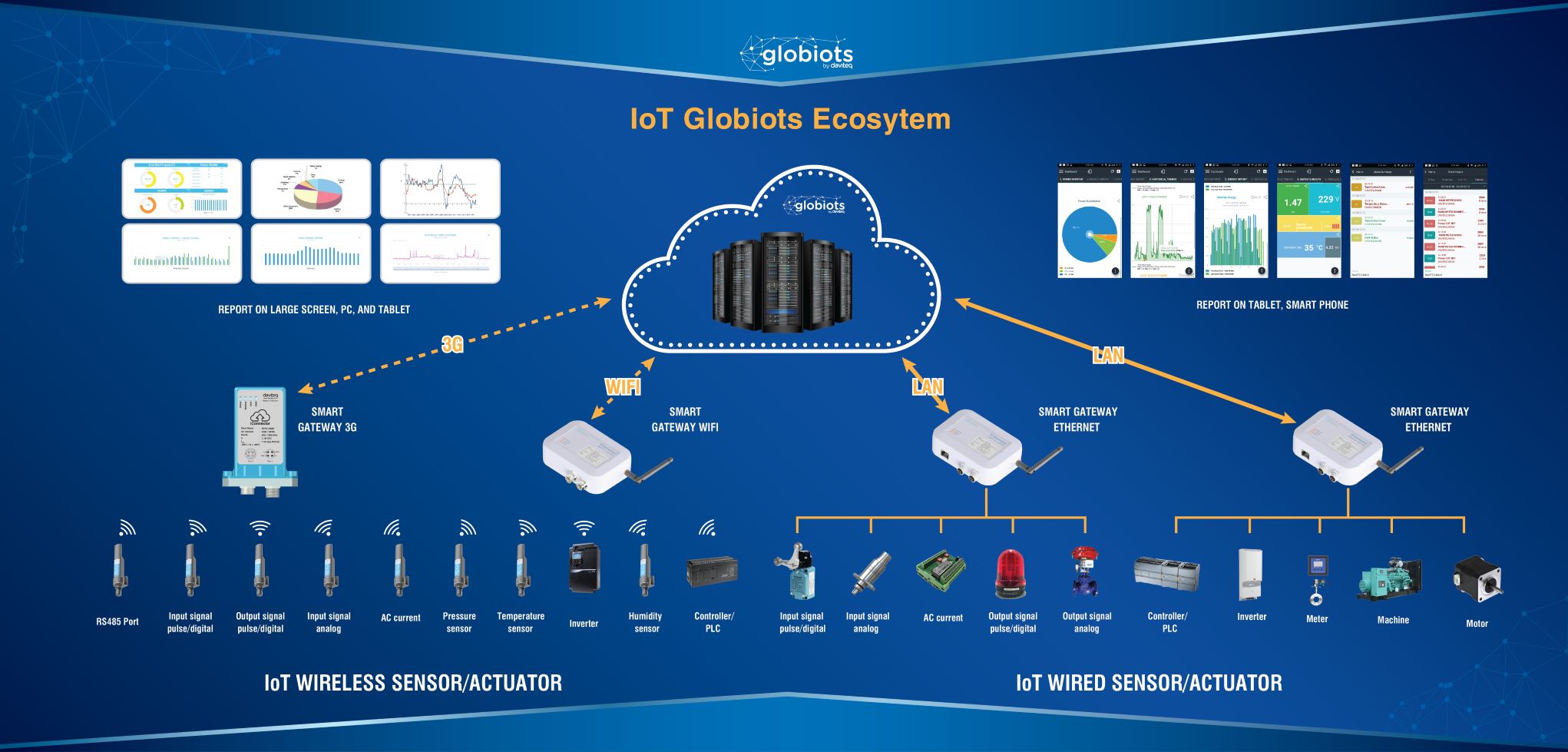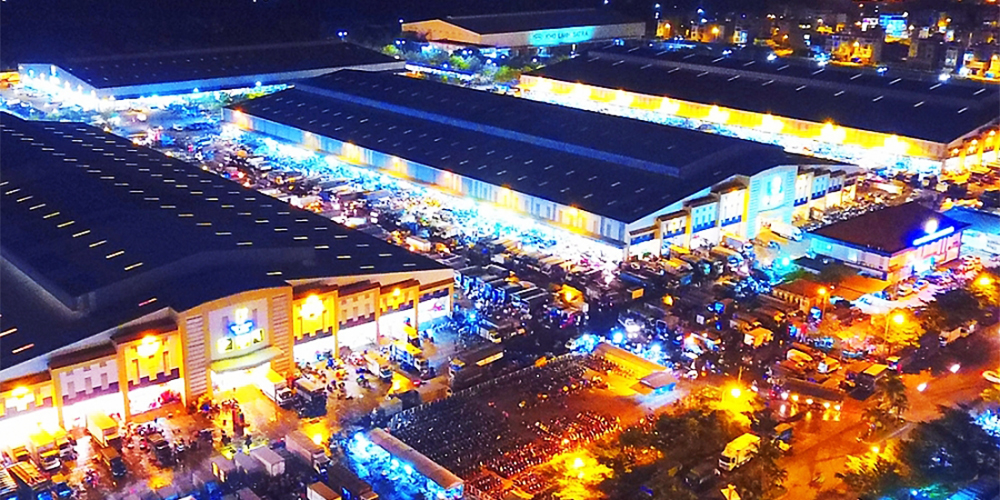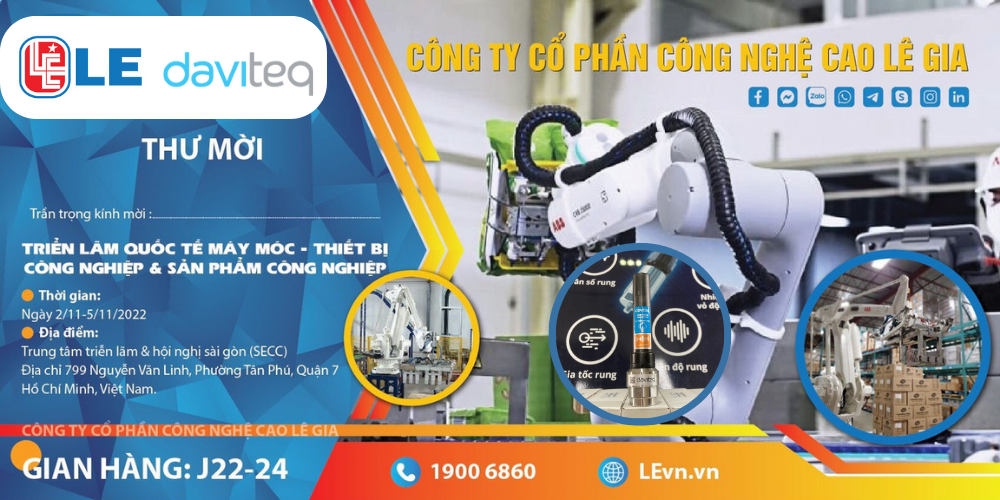For human life, humidity affects health a lot. If the humidity is too high 90%, people will increase the risk of arthritis, cough, asthma, headaches and several other chronic diseases. Irritating fatigue, too high humidity is also a condition for harmful bacteria and fungi to grow. Also affects electronics and furniture in the house. Have you ever wondered what humidity is that can affect your life so much. How can we measure moisture and how do we increase or decrease it? This article will help you answer these questions.
1. Humidity
Humidity is the concentration of water vapor presenting in the air. The steam, the gaseous state of water, is hard to see with the human eye. Humidity indicates the possibility of rain, mist, or fog. The higher the humidity, the less effective it is to cool down our bodies, which is why sometimes hot summers don’t make us as uncomfortable as hot humid autumn days.

Fog in a tropical rainforest (Source: Wikipedia)
Humidity has 3 concepts: absolute humidity, relative humidity and specific humidity.
Absolute humidity describes the water content of gas and is expressed in grams per cubic meter (g/cm³). However, absolute humidity changes when the air pressure changes. This is extremely inconvenient for technical chemistry calculations (e.g for a clothes dryer, since its temperature can vary significantly). Therefore absolute humidity is often defined in engineering chemistry as the mass of water vapor per unit mass of dry air.
Relative humidity indicates the current state of absolute humidity relative to maximum humidity at the same temperature, expressed as a percentage (%).
Specific humidity is the ratio of the mass of water vapor to the total mass of the humid air.
2. Relative Humidity
The relative humidity (RH or ϕ) of the water-gas mixture is defined as the ratio between the partial pressure of the steam and the saturated vapor pressure of the water at the same temperature, expressed as a percentage:
Relative humidity is usually expressed as a percentage (%); The more humid the air, the higher the relative humidity. When the relative humidity reaches 100%, the air is already saturated with water vapor and is at the dew point(1).
Relative humidity is different from absolute humidity – defined as the mass of water vapor contained in 1 m³ of air. Absolute humidity does not indicate the humidity level of the air because at a lower temperature the more water vapor in the air is saturated. Therefore, to describe the humidity of air, relative humidity is used. Relative humidity can be measured with a hygrometer, called a hygrometer.
(1)The dew point is the dew condensation point of an air mass, at a constant atmospheric pressure, the temperature at which the water vapor content of the air mass condenses into liquid water. In other words, the dew point is the temperature at which the relative humidity of the air mass reaches 100%.
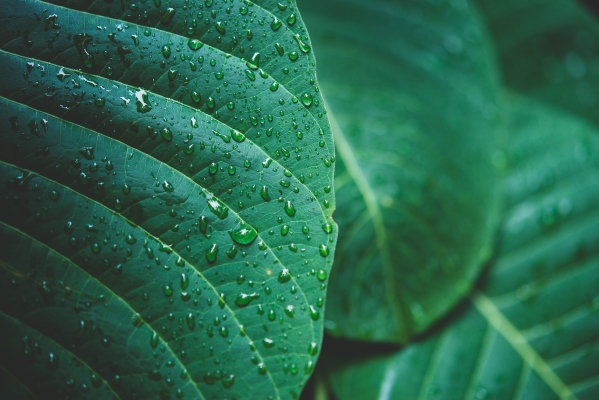
Dew condenses on the leaf
3. The Difference Between Humidity and Relative Humidity
Humidity is the amount of water vapor in the atmosphere, and relative humidity is a concept of humidity.
Humidity is the water content of the mixture of steam and other elements present in the air. Relative humidity is the percentage of water vapor in the air at a given temperature.
Humidity is used to determine the likelihood of rain, fog or mist occurring.
Relative humidity is used for climate control and how it affects human’s health, comfort and safety.
Relative humidity is also used to ensure safety for machines, vehicles and buildings. Also determining the humidity of a certain place provides data to forecast the weather.
4. Method of Measuring the Relative Humidity
Currently, there are 3 main methods used to measure humidity: electronic hygrometer, psychrometer and dew point measuring device. The dew point measuring device is the most accurate and is often used as a standard for calibrates.
Electronic hygrometer based on sensors such as capacitance, resistance, gravity, and optical to measure humidity, accompanied by a temperature sensor to measure the ambient temperature.
Principle of relative humidity measurement for capacitive hygrometer, air flowing between two metal plates, the change of air humidity is proportional to the capacitance change between the two plates.
For a resistive hygrometer, the polymer or ceramic absorbs moisture, which then affects its resistivity and is connected to an electrical circuit in which the moisture affects the resistance of the material. From there the relative humidity is determined based on the change in the current. This measurement method is suitable for measuring humidity between 15% and 95%, with an uncertainty of ± 3%.
In fact, to measure the relative humidity, capacitance type sensors are often used, because capacitive sensors are cheaper and more reliable than other sensors. However, the durability of the wireless sensor depends greatly on the operating environment. If working in an environment with a lot of dust or solvent gases, the sensor will damage more quickly, so there must be a dust filter to prolong the life of the sensor.
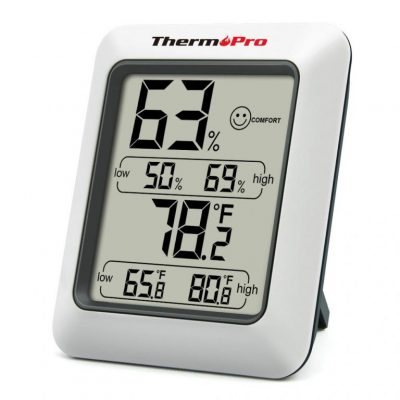
Types of electronic hygrometer (Source: ThermoPro)
The Psychrometer has two thermometers, one wet bulb and one dry bulb thermometer. The bulb of the wet bulb thermometer is covered with a damp cloth. When the psychrometer is “suspended” or rotated, air is blown through both thermometers. The wet bulb thermometer is cooled by evaporation, and its reading decreases. The relative humidity is determined by comparing the wet and dry thermometer bulb temperatures. The lowest possible measurement uncertainty is ± 4%.
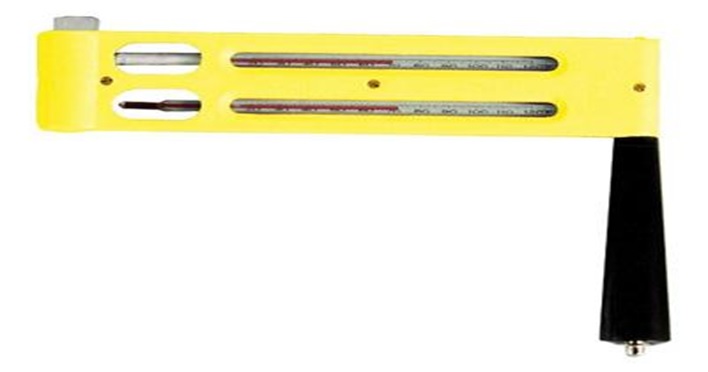
Psychrometer (Source: Certifiedmtp.com)
The dew point measuring device is structured as shown in picture. The sample is inserted into a jar with an electrically cooled mirror face. The mirror surface is cooled until the light source detection system detects dew formation on the mirror, and the condensing temperature is measured with a sensor attached to the mirror surface. The dew point is the temperature at which the sample becomes saturated with water. Therefore, this temperature is related to the moisture level in the sample. A microscope is also provided in the instrument so that the thickness and nature of the condensate can be observed. Even small levels of contaminants on the surface of the mirror can cause large variations in dew point, and therefore the instrument must be kept very clean. When necessary, the mirror should be cleaned with deionized or distilled water.
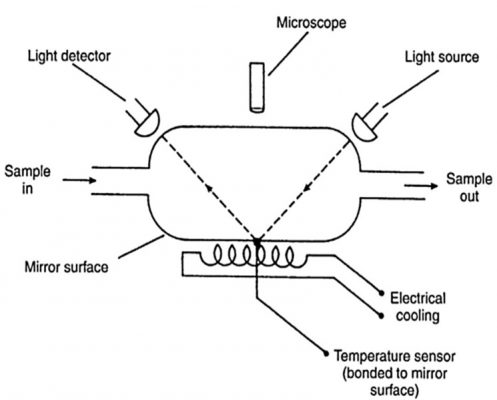
Construction of a dew point measuring device (Source: Book Measurement and Instrumentation, Second Edition Theory and Application by Alan S Morris, Reza Langari)
5. Important of Measuring and Monitoring of Relative Humidity
By far the biggest reason to monitor relative humidity is to control the humidity around the end product. In most cases, this means making sure the RH never gets too high. For example, let’s take a product like chocolate. If the RH in the storage facility rises above a certain level and remains above that level for a sufficiently long time, a phenomenon known as blooming may occur. This is where moisture forms on the surface of the chocolate, dissolving the sugar. As moisture evaporates, sugars form larger crystals, which leads to discoloration.
Humidity is also a big problem for products that are extremely sensitive to moisture, such as some pharmaceuticals. This is because it can alter the properties of a pharmaceutical product until it becomes useless, which is why products such as medical pills and dry powders are stored under controlled conditions (control at precise humidity and temperature).
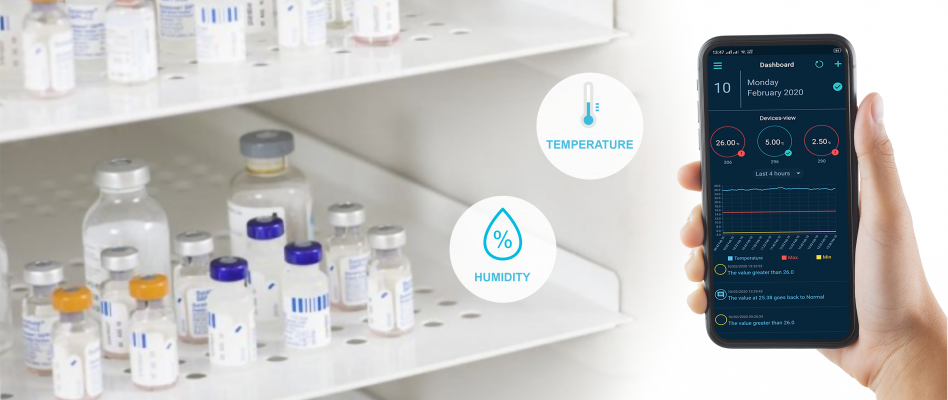
Humidity and temperature monitoring for vaccine, pharmaceutical warehouse
Finally, relative humidity is also a key factor in building automation systems – focus on human comfort, such as air conditioning. The ability to measure and control RH not only helps to maintain a comfortable environment inside the building, but also helps optimize the efficiency of the HVAC system(1) by providing an indication of the amount of outside air. The intake should be conditioned, based on the outside temperature.
(1)The abbreviation of Heating, Ventilating, and Airconditioning is collectively referred to as the air conditioning system.
6. Humidity Measurement Device
Humidity measurement device (moisture analyzer) is a familiar and popular device in everyday life. You can easily see the display of temperature and humidity at airports, restaurants, hotels … It is also a form of humidity measurement device.
Humidity measurement device is a device made and manufactured to serve the function of determining the humidity (the ratio of water) in the environment, air or a certain substance. For example in the types of materials: wood, paper…; types of construction materials: mortar, concrete, wall…; fiber materials: cotton, fabric…; medicines and pharmaceuticals in health; preserving agricultural products, foodstuffs.
Humidity measurement device is very diverse. Since ancient times, people have created tools such as hair hygrometer, wet dry moisture meter, dew point hygrometer … to measure humidity and apply to measuring humidity in the air, some agricultural products … The tools are rudimentary, manual and the accuracy is not high. Nowadays, with the development of science and technology, we have very convenient and useful electronic humidity measurement devices.
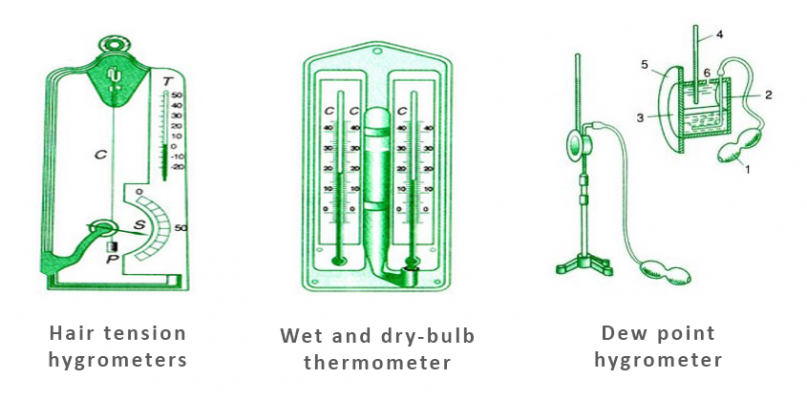
Classic hygrometer (Source: Tulieu.violet.vn)
Currently, humidity electronic measurement devices are more commonly used because of the quick and convenient they provide. These devices are modernly designed, apply advanced and intelligent technologies not only measure the surface moisture of materials but also have the ability to measure moisture inside, through many layers of materials; help users save a lot of time, effort and achieve high efficiency.
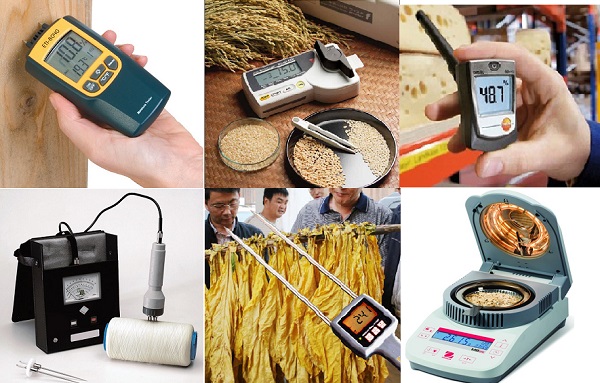
Some popular types of hygrometer (Source: maydochuyendung)
According to this classification, the hygrometer is divided into 7 main groups:
- Moisture meter for wood, paper, sawdust, wall, concrete. This group includes the types of: wood moisture meter, concrete wall moisture meter, soil moisture meter … They are mainly used in the fields of woodworking and processing, construction, agriculture …
- Moisture meter for grains and agricultural products. This group includes moisture meters for grains, grains: rice, coffee, flour, etc. and mainly applied in agriculture and food and food processing production.
- Moisture meter for cotton, fabric, fiber. This group is mainly used in the garment industry. They help users determine the moisture content of fabrics.
- Moisture meter for coal, industrial chemicals. This group is capable of measuring the moisture content of a wide range of materials in the chemical industry.
- Humidity meter, air temperature. This group is mainly used for the activities of monitoring temperature and humidity, research activities and analysis of weather and climate. In addition, this group also includes hygrometer, portable thermometer – devices commonly used in homes, warehouses, restaurants, hotels …
- Moisture analytical balance (moisture analysis balance), this model can be a very versatile device that can have moisture analysis scale models that perform the functions of all 6 above machines. They are commonly used in measurement laboratories for research purposes.
7. Humidity Combined Temperature Controller
With the importance of measuring and monitoring humidity outlined in section 5 and the hygrometer introduced in section 6, we can see that measuring and monitoring humidity and temperature is very necessary for many fields and trades in human life. So have you ever wondered, after measuring the humidity and temperature parameters with a handheld device or sensor, how do we want to increase or decrease the humidity of an environment. This section will help to answer your question about relative humidity and temperature controllers.
Humidity and temperature control can be via an integrated set of sensors and controllers. This is the simplest control method but the error will be high. To control for more advanced systems, we need humidity sensors with an output of 4-20mA current, voltage 0-10VDC. It can connect with a PID controller or PLC for precise humidity and temperature control, data collection and remote monitoring.
Controlling humidity and temperature, the first thing is that we need a humidity sensor with built-in temperature measurement. The most important factor in the humidity control process. Should be a sensor with high reliability, stable operation, fast response. Here we can refer to humidity sensors integrated temperature measurement features of some brands such as: Omron, PCE, Daviteq, …
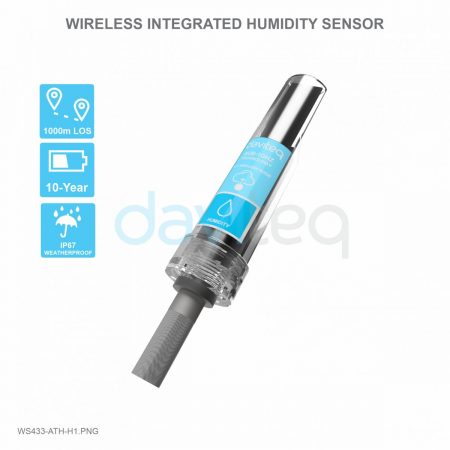
Integrated wireless humidity sensor by Daviteq
Secondly The most important is the humidity and temperature controller, in the controller there is PID control mode with analog output 4-20mA, 0-10VDC. When the controller has integrated PID mode, the controller will automatically maintain the desired humidity and temperature without having to set many complicated parameters. As long as the user selects the desired humidity and temperature, everything for the controller to work.
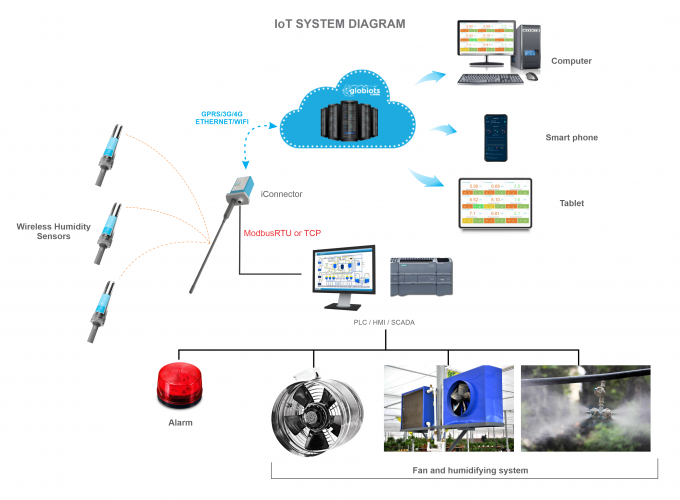
System control and monitoring temperature, humidity
In addition, humidity and temperature controller, we can choose to integrate RS485 communication port. With this port we can connect the humidity and temperature controller to the computer or laptop. We can observe and control humidity from a distance without having to go to the controller area. Moreover, collecting data and storing information according to the sampling cycle is no longer a difficult problem. With the connection to a computer, we can store all the humidity and temperature data over time.
Normally, the humidity and temperature controller will control the output which are mist generators, heat fans, air conditioners, convection fans, …
8. Conclusion
The amount of knowledge about relative humidity is so much that we cannot describe it all through just one article. But we hope that the article can help you partly understand more about relative humidity, the importance of measuring and monitoring relative humidity in life around us and ultimately help you to understand more about the role and how each component works in a complete humidity control system. If you are interested in more details or have questions related to the article, please contact us at info@daviteq.com


 Tiếng Việt
Tiếng Việt



